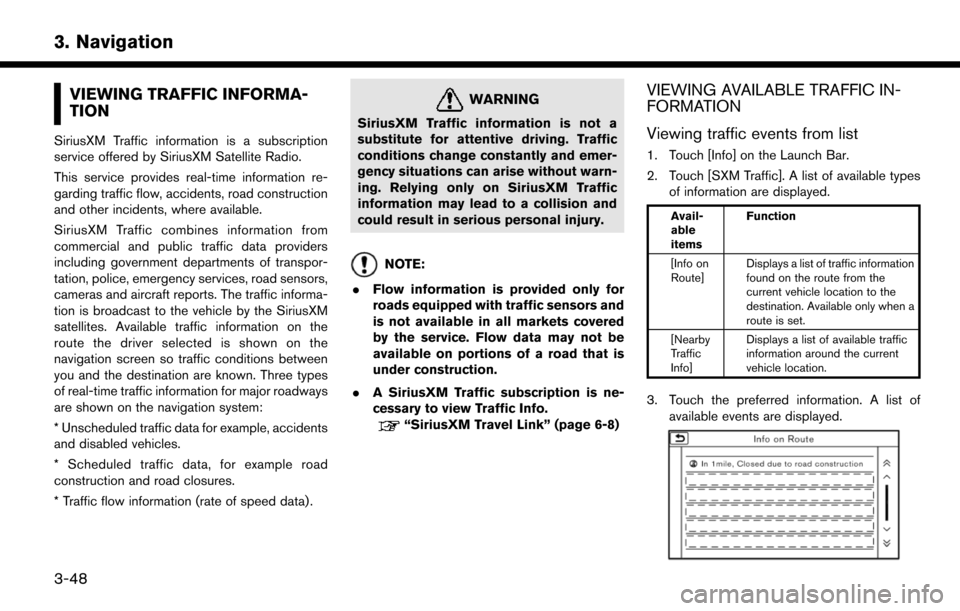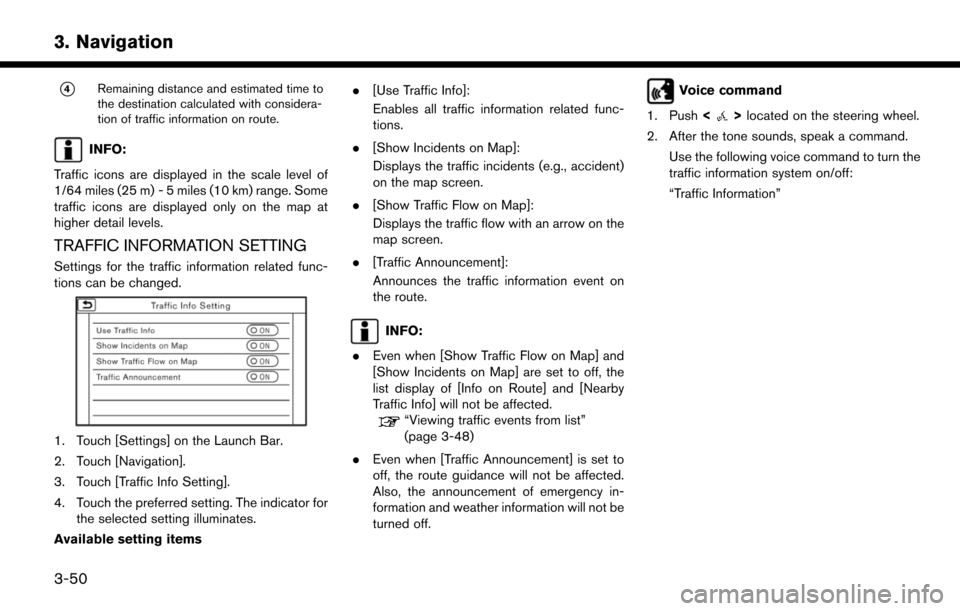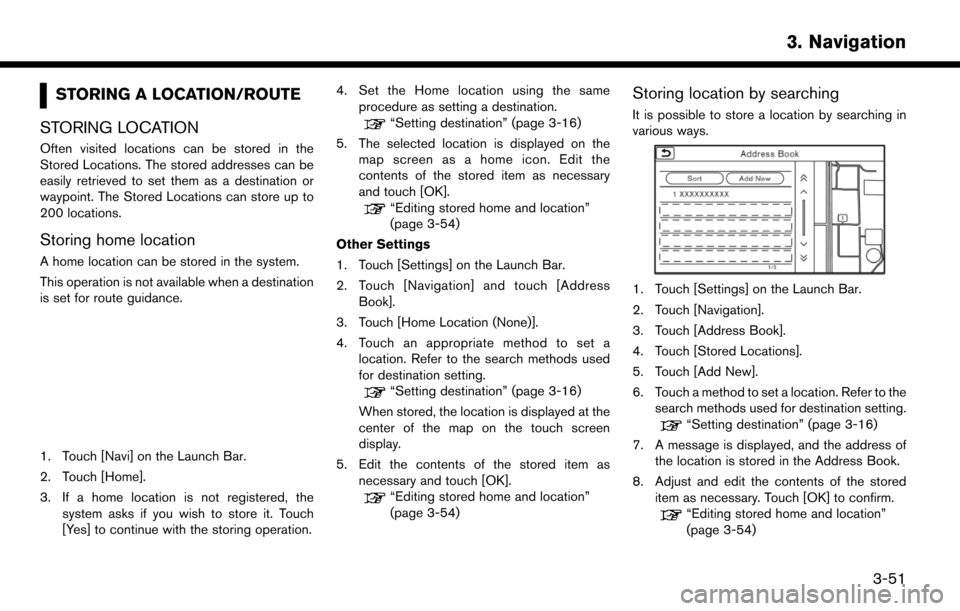2017 NISSAN LEAF navigation system
[x] Cancel search: navigation systemPage 107 of 268
![NISSAN LEAF 2017 1.G Navigation Manual [Use Ferries]Includes the use of ferries.
[Use Learned Routes] Uses the roads that are most frequently traveled with the help of
self-learning technology.
[Use HOV Lanes] Uses the HOV lanes.
[Auto Rer NISSAN LEAF 2017 1.G Navigation Manual [Use Ferries]Includes the use of ferries.
[Use Learned Routes] Uses the roads that are most frequently traveled with the help of
self-learning technology.
[Use HOV Lanes] Uses the HOV lanes.
[Auto Rer](/manual-img/5/531/w960_531-106.png)
[Use Ferries]Includes the use of ferries.
[Use Learned Routes] Uses the roads that are most frequently traveled with the help of
self-learning technology.
[Use HOV Lanes] Uses the HOV lanes.
[Auto Reroute] If the vehicle deviates from the suggested route, the system
automatically recalculates a route that leads the vehicle to the
suggested route.
INFO:
. If the vehicle greatly deviates from the suggested route, the system calculates a new route.
. Traffic jam information displayed on the map screen is not statistical traffic information.
. If [Do Not Use Restriction Info] is selected for [Time Restricted Rd] setting, the system calculates a route without any consideration of the regulations
concerning the time or day of the week. Therefore, the suggested route may include a road subject to traffic regulations concerning the time or day of the
week. When driving along the route, always follow all traffic regulations regardless of whether [Time Restricted Rd] is set to be considered or not.
. Even when [Use Real Time Traffic Information] is turned on, if traffic information has not been provided for the area, a detour may not always be indicated
in a location where a traffic jam occurs.
. The system calculates to reduce the time required for the entire route from the start to the destination. If there are no appropriate routes, the system may
lead to a route where a traffic jam occurs instead of leading to a detour.
. The system may not lead to a detour if traffic closure or a traffic jam occurs far from the present location.
3-47
3. Navigation
Page 108 of 268

VIEWING TRAFFIC INFORMA-
TION
SiriusXM Traffic information is a subscription
service offered by SiriusXM Satellite Radio.
This service provides real-time information re-
garding traffic flow, accidents, road construction
and other incidents, where available.
SiriusXM Traffic combines information from
commercial and public traffic data providers
including government departments of transpor-
tation, police, emergency services, road sensors,
cameras and aircraft reports. The traffic informa-
tion is broadcast to the vehicle by the SiriusXM
satellites. Available traffic information on the
route the driver selected is shown on the
navigation screen so traffic conditions between
you and the destination are known. Three types
of real-time traffic information for major roadways
are shown on the navigation system:
* Unscheduled traffic data for example, accidents
and disabled vehicles.
* Scheduled traffic data, for example road
construction and road closures.
* Traffic flow information (rate of speed data) .
WARNING
SiriusXM Traffic information is not a
substitute for attentive driving. Traffic
conditions change constantly and emer-
gency situations can arise without warn-
ing. Relying only on SiriusXM Traffic
information may lead to a collision and
could result in serious personal injury.
NOTE:
. Flow information is provided only for
roads equipped with traffic sensors and
is not available in all markets covered
by the service. Flow data may not be
available on portions of a road that is
under construction.
. A SiriusXM Traffic subscription is ne-
cessary to view Traffic Info.
“SiriusXM Travel Link” (page 6-8)
VIEWING AVAILABLE TRAFFIC IN-
FORMATION
Viewing traffic events from list
1. Touch [Info] on the Launch Bar.
2. Touch [SXM Traffic]. A list of available types
of information are displayed.
Avail-
able
items Function
[Info on
Route] Displays a list of traffic information
found on the route from the
current vehicle location to the
destination. Available only when a
route is set.
[Nearby
Traffic
Info] Displays a list of available traffic
information around the current
vehicle location.
3. Touch the preferred information. A list of
available events are displayed.
3-48
3. Navigation
Page 110 of 268

*4Remaining distance and estimated time to
the destination calculated with considera-
tion of traffic information on route.
INFO:
Traffic icons are displayed in the scale level of
1/64 miles (25 m) - 5 miles (10 km) range. Some
traffic icons are displayed only on the map at
higher detail levels.
TRAFFIC INFORMATION SETTING
Settings for the traffic information related func-
tions can be changed.
1. Touch [Settings] on the Launch Bar.
2. Touch [Navigation].
3. Touch [Traffic Info Setting].
4. Touch the preferred setting. The indicator for the selected setting illuminates.
Available setting items .
[Use Traffic Info]:
Enables all traffic information related func-
tions.
. [Show Incidents on Map]:
Displays the traffic incidents (e.g., accident)
on the map screen.
. [Show Traffic Flow on Map]:
Displays the traffic flow with an arrow on the
map screen.
. [Traffic Announcement]:
Announces the traffic information event on
the route.
INFO:
. Even when [Show Traffic Flow on Map] and
[Show Incidents on Map] are set to off, the
list display of [Info on Route] and [Nearby
Traffic Info] will not be affected.
“Viewing traffic events from list”
(page 3-48)
. Even when [Traffic Announcement] is set to
off, the route guidance will not be affected.
Also, the announcement of emergency in-
formation and weather information will not be
turned off.
Voice command
1. Push <
>located on the steering wheel.
2. After the tone sounds, speak a command. Use the following voice command to turn the
traffic information system on/off:
“Traffic Information”
3-50
3. Navigation
Page 111 of 268

STORING A LOCATION/ROUTE
STORING LOCATION
Often visited locations can be stored in the
Stored Locations. The stored addresses can be
easily retrieved to set them as a destination or
waypoint. The Stored Locations can store up to
200 locations.
Storing home location
A home location can be stored in the system.
This operation is not available when a destination
is set for route guidance.
1. Touch [Navi] on the Launch Bar.
2. Touch [Home].
3. If a home location is not registered, the system asks if you wish to store it. Touch
[Yes] to continue with the storing operation. 4. Set the Home location using the same
procedure as setting a destination.
“Setting destination” (page 3-16)
5. The selected location is displayed on the map screen as a home icon. Edit the
contents of the stored item as necessary
and touch [OK].
“Editing stored home and location”
(page 3-54)
Other Settings
1. Touch [Settings] on the Launch Bar.
2. Touch [Navigation] and touch [Address Book].
3. Touch [Home Location (None)].
4. Touch an appropriate method to set a location. Refer to the search methods used
for destination setting.
“Setting destination” (page 3-16)
When stored, the location is displayed at the
center of the map on the touch screen
display.
5. Edit the contents of the stored item as necessary and touch [OK].
“Editing stored home and location”
(page 3-54)
Storing location by searching
It is possible to store a location by searching in
various ways.
1. Touch [Settings] on the Launch Bar.
2. Touch [Navigation].
3. Touch [Address Book].
4. Touch [Stored Locations].
5. Touch [Add New].
6. Touch a method to set a location. Refer to thesearch methods used for destination setting.
“Setting destination” (page 3-16)
7. A message is displayed, and the address of the location is stored in the Address Book.
8. Adjust and edit the contents of the stored item as necessary. Touch [OK] to confirm.
“Editing stored home and location”
(page 3-54)
3-51
3. Navigation
Page 112 of 268
![NISSAN LEAF 2017 1.G Navigation Manual INFO:
. When the location is stored in the Stored
Locations, [Address Book] can be used to
search for the location.
“Searching from address book”
(page 3-23)
. When 200 locations are already store NISSAN LEAF 2017 1.G Navigation Manual INFO:
. When the location is stored in the Stored
Locations, [Address Book] can be used to
search for the location.
“Searching from address book”
(page 3-23)
. When 200 locations are already store](/manual-img/5/531/w960_531-111.png)
INFO:
. When the location is stored in the Stored
Locations, [Address Book] can be used to
search for the location.
“Searching from address book”
(page 3-23)
. When 200 locations are already stored, a
new location cannot be stored until a
currently stored location is deleted.
Storing location by moving map
1. Move to the preferred location on the map
and touch [] on the touch screen display.
2. Touch [Save Location]. A message is dis-
played.
3. The icon representing the stored location is displayed on the map. Push
VOICE> to return to the current location
map screen.
STORING ROUTE
A maximum of 5 calculated routes can be stored.
Stored routes can be easily retrieved and set as
the suggested route.
If any waypoints are not set on the route, the
route cannot be stored.
1. Touch [Navi] on the Launch Bar.
2. Touch [Route Info].
3. Touch [Store Route]. A confirmation mes- sage is displayed. Select [Yes] to store the
current route.
Other settings
A route can also be stored using the following
procedure.
1. Touch [Settings] on the Launch Bar.
2. Touch [Navigation].
3. Touch [Address Book].
4. Touch [Stored Routes].
5. Touch [Store Current Route]. A confirmation message is displayed.
6. Confirm the contents of the message and touch [Yes]. The current route is stored.
INFO:
. At least 1 waypoint must be set for the route
to be stored.
. A stored route includes only locations
(destination and waypoints) and route cal-
culation conditions, not the route itself.
. The route is stored in the first available
position number in the store current route
list.
. When 5 routes are already stored in the
address book, a new route cannot be stored
until a route is deleted.
“Deleting stored item” (page 3-56)
STORING AVOID AREA
An Avoid Area can be stored. The Avoid Area is
an area that can be excluded from a route, such
as a road that is always congested. Once Avoid
Areas are stored, the system avoids those areas
when calculating a route. Up to 10 Avoid Areas
can be stored.
1. Touch [Settings] on the Launch Bar.
2. Touch [Navigation].
3. Touch [Address Book].
4. Touch [Avoid Area].
3-52
3. Navigation
Page 113 of 268
![NISSAN LEAF 2017 1.G Navigation Manual 5. Touch [Add New].Touch an appropriate method to search for a
location.
“Setting destination” (page 3-16)
6. Adjust the information of the Avoid Area as necessary.
“Editing avoid area” (page NISSAN LEAF 2017 1.G Navigation Manual 5. Touch [Add New].Touch an appropriate method to search for a
location.
“Setting destination” (page 3-16)
6. Adjust the information of the Avoid Area as necessary.
“Editing avoid area” (page](/manual-img/5/531/w960_531-112.png)
5. Touch [Add New].Touch an appropriate method to search for a
location.
“Setting destination” (page 3-16)
6. Adjust the information of the Avoid Area as necessary.
“Editing avoid area” (page 3-56)
7. Touch [OK] to store the avoid area informa- tion.
INFO:
. A maximum of 10 Avoid Areas can be stored.
When 10 Avoid Areas are already stored, a
new Avoid Area cannot be stored until a
currently stored Avoid Area is deleted.
“Deleting stored item” (page 3-56)
EDITING STORED INFORMATION
Items stored in the system can be edited.
3-53
3. Navigation
Page 115 of 268
![NISSAN LEAF 2017 1.G Navigation Manual [Voicetag]Registers a voicetag for the entry which allows the
entry to be used with the voice recognition system.
[Charging Sta. Att.] [Quick Charge Station]The location is registered as a charging st NISSAN LEAF 2017 1.G Navigation Manual [Voicetag]Registers a voicetag for the entry which allows the
entry to be used with the voice recognition system.
[Charging Sta. Att.] [Quick Charge Station]The location is registered as a charging st](/manual-img/5/531/w960_531-114.png)
[Voicetag]Registers a voicetag for the entry which allows the
entry to be used with the voice recognition system.
[Charging Sta. Att.] [Quick Charge Station]The location is registered as a charging station with
quick charge equipment and can be included in the
charging station search.
[Normal
Charge Sta-
tion] The location is registered as a s charging station
with normal charge equipment and can be included
in the charging station search.
[Not a Charge
Station] The location is registered as a location that is not a
charging station.
[Icon] Selects an icon for the entry.
[Sound] Sets the type of the alarm that sounds when the
vehicle approaches the location.
[Direction] Sets the alarm to sound when approaching from a
specific direction.
[Distance] Sets the alarm to sound when reaching a specific
distance to the location.
[Phone No.] Registers a phone number of the location.
[Group] Registers a group of the entry.
[Entry Numbers] Registers an entry number for the location.
[Move Location] Adjusts the stored location information.
[Delete] Deletes the stored location information.
[OK] Confirms and saves the edited stored location
information.
3-55
3. Navigation
Page 117 of 268
![NISSAN LEAF 2017 1.G Navigation Manual Deleting stored item individually
1. Touch [Settings] on the Launch Bar.
2. Touch [Navigation] and touch [Address Book].
3. Touch [Delete Stored Items].Select the preferred item and touch [Yes] to com NISSAN LEAF 2017 1.G Navigation Manual Deleting stored item individually
1. Touch [Settings] on the Launch Bar.
2. Touch [Navigation] and touch [Address Book].
3. Touch [Delete Stored Items].Select the preferred item and touch [Yes] to com](/manual-img/5/531/w960_531-116.png)
Deleting stored item individually
1. Touch [Settings] on the Launch Bar.
2. Touch [Navigation] and touch [Address Book].
3. Touch [Delete Stored Items].Select the preferred item and touch [Yes] to complete the deleting operation.
Step 1 Step2 Action
[Delete Home Location] Deletes home location.
[Delete Address
Book] [Delete All]
Deletes all stored locations.
[Delete One] Deletes a selected stored location.
[Delete Stored
Routes] [Delete All]
Deletes all stored routes.
[Delete One] Deletes selected stored routes.
[Delete Avoid
Areas] [Delete All]
Deletes all Avoid Areas.
[Delete One] Deletes a selected Avoid Area.
[Delete Pre-
vious Destina-
tions] [Delete All Previous Destinations] Deletes all of the previous destinations.
[Delete Previous Destination] Deletes a selected previous destination.
[Delete Previous Start Point] Deletes a previous start point.
[Delete Learned Routes] Deletes all system learned routes.
Deleting individual item on map
1. Align the cross pointer over the preferred
stored location for deletion by moving on the
map, and then touch [
].
2. Touch [Delete].
3. A confirmation message is displayed. Con-
firm the contents of the message and touch
[Yes].
The stored item is deleted from the Address
Book.
TRANSFERRING INFORMATION TO/
FROM ADDRESS BOOK
The information of the stored home and ad-
dresses can be exported and imported using a
USB memory device.
“USB (Universal Serial Bus) Connection
Port and AUX (auxiliary) input jack”
(page 1-5)
3-57
3. Navigation